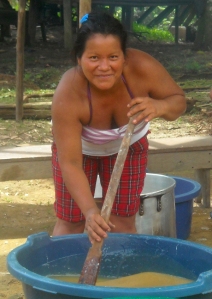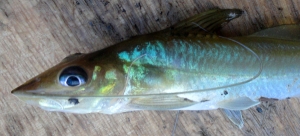By Campbell Plowden
It had been an intense first week in the Ampiyacu full of meetings, workshops, and long days in the field. I was really looking forward to going fishing on Sunday to relax. Our long-time friend Beder agreed to take Luke, Amrit and me out in his boat, but we had to get back to Brillo Nuevo in time for the Father’s Day festivities. I had enjoyed getting a card from my kids in the past, but given the choice I thought I would rather spend more time on the river.
Beder motored us to some of the favorite local spots up the Yaguasyacu River and quickly used a few bits of worms to catch small fish which became bait for others. While Luke and I were the more experienced fishermen, but even though Amrit is a life-long vegetarian, she had the best luck (or skill) among our trio bringing in a couple of catfish.
Thanks to the clever pirañas, though, we spent more time replacing bait on our hooks than pulling fish in for our dinner. We called it a morning after about three hours and headed back to the village.
As Beder had predicted, people were just gathering on the stands overlooking the village’s main soccer field to view and participate in the Father’s Day activities about two hours after they were supposedly due to begin. I’d heard that there were going to be various games – some quite physical, but when I heard there was going to be a singing contest, I told the head teacher master of ceremonies that I wanted to enter that.
It, therefore, came as a surprise when he called me to the front and announced that I was going to open the event with a song about fathers. I didn’t really know any songs appropriate to the event so I gave my best wholehearted acapella rendition of the Indian national anthem in Hindi – the only true Indian song I knew.
The head teacher and one woman from the village then each gave a speech to explain why we had gathered on that day. I was expecting pro-forma remarks that frequently accompany grand events, but I was genuinely moved. They both talked about the critical role that men and fathers played in the lives of their children, their wife, and their community. It was their job to provide for their family by working hard to bring home food from their fields, forest and fishing and to earn enough money to buy clothing and supplies for their kids to go to school. They needed to gather to discuss and make decisions about issues affecting the village and participate in collective activities that benefited everyone. Beyond their role as providers and leaders, it was also their job to care for and love their family.
At first, the speeches felt like calls to stimulate appreciation for all of the fathers in the community. I felt a bit later, though, that the talks were also intended to directly remind the dads about their responsibilities since a number of them seemed to be remiss in fulfilling some of these. It was distressing to me that it was hard to hear these remarks clearly since they were delivered without a microphone in competition with loud cumbia music coming from the boom box of a house immediately across the soccer pitch.
After these intro remarks, the teacher said something like, “let the games begin!”
Most of the games began by the call for two to three volunteers – sometimes with and sometimes without knowing what the contest was going to be ahead of time. The first one I jumped into matched with one other dad – I think a good bit older than me – and another pair of dads in a sort of Mummy race. I stood still with my arms next to my side while my partner wrapped toilet paper around me from toes to head. He didn’t make very fast progress, though, because the low-grade tissue kept breaking off after winding a foot or so around my legs. We lost by a head, but it was a lot of fun.

Bora Dad searching for head lice in his daughter. Photo by Campbell Plowden/Center for Amazon Community Ecology
Subsequent games involved real tests of stamina and strength including a sack race, wheel barrow race, and a piggy back race where Dads took turns running to one side of the muddy field and back holding their partner back to back with locked elbows. I tried my hand at the nailing contest, but I was still working on hammering my second nail into the board while both of my fellow contestants pounded home their winning third. The funkiest contest awarded a prize to the dad who was the first to pick out 3 lice from the head of his child – a race not likely to be seen at a 4th of July picnic in the U.S.
Two eating contest challenged two men to down as much of a large plate of spaghetti, bowl of cereal, two bananas, bag of popcorn and large bottle of soda as they could in five minutes – another involved a race between a pair to be the first to finish 3 large red onions.

Men doing women’s hair at Brillo Nuevo. Photo by Campbell Plowden/Center for Amazon Community Ecology

Husbands doing wives makeup at Brillo Nuevo. Photo by Campbell Plowden/Center for Amazon Community Ecology
The funniest events were two involving couples – one where the husband had three minutes to comb his wife’s long hair into some semblance of a fancy doo, the other where hubby had to put makeup on his spouse. It was hard to get volunteers for this latter event, but the winner did a passable job of making his wife look ready for a night out in the wrong part of town. The winners were chosen by acclaim from the crowd along with a prize.

Campbell Plowden playing volleyball at Brillo Nuevo. Photo by Amrit Moore/Center for Amazon Community Ecology
After these games with pairs, they strung a net across two posts for volleyball. When they called for volunteers for the first match, I reluctantly allowed myself to be drafted fearing that I was going to further demonstrate my ineptitude at an activity that most of these folks had played their whole lives. What gave me a little hope was that while my 5 foot, 10 inch height is average in the U.S., it made me the tallest man on the field here. I lacked the hitting finesse of my team mates, but our strongest player Antonio kept yelling out “Doctor!” to set me up to jump up and knock the ball over the net.

Campbell Plowden playing volleyball at Brillo Nuevo. Photo by Amrit Moore/Center for Amazon Community Ecology

Bora woman making masato at Brillo Nuevo. Photo by Campbell Plowden/Center for Amazon Community Ecology
Learn more about or donate to CACE’s project in Peru at: www.AmazonAlive.net








